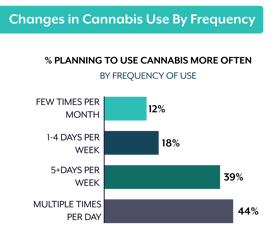 “Essential” took on a loose form as many states shut down to slow the spread of COVID-19. Among the businesses deemed “essential” were pawnshops, gun ranges, bike dealers, and in one Michigan town, a coin collector’s store. Of course, for many jurisdictions, “essential” also included the cannabis industry—and Brightfield's data confirms many Americans increased their frequency of use during the lockdown. But as we “reopen” and attempt to recapture our old lives, what will the US Cannabis industry look like?
“Essential” took on a loose form as many states shut down to slow the spread of COVID-19. Among the businesses deemed “essential” were pawnshops, gun ranges, bike dealers, and in one Michigan town, a coin collector’s store. Of course, for many jurisdictions, “essential” also included the cannabis industry—and Brightfield's data confirms many Americans increased their frequency of use during the lockdown. But as we “reopen” and attempt to recapture our old lives, what will the US Cannabis industry look like?
Short answer: the jury is still out. And it could be awhile before we really see what trends will emerge.
Changes at the Consumer Level
 At the micro level, if people work from home more, use in the house could become more common (perhaps even during work), especially as employees physically commute less. Cannabis can also be a healthy way to cope with the side-effects of being cooped up—like anxiety and inflammation. Companies would be wise to pursue specific lines and products that cater to the ailments from staying inside more.
At the micro level, if people work from home more, use in the house could become more common (perhaps even during work), especially as employees physically commute less. Cannabis can also be a healthy way to cope with the side-effects of being cooped up—like anxiety and inflammation. Companies would be wise to pursue specific lines and products that cater to the ailments from staying inside more.
Covid-19 is a viral, respiratory, pandemic. However, most consumers did not adjust their flower or vape habit. Our surveys from March and April 2020 indicated only 7% of cannabis consumers plan to use fewer inhalable products. There may be still be a window for firms to aggressively brand themselves as the “healthiest” or “lightest” form of flower. Users themselves might seek their own, proprietary joints, bongs, and vapes to limit the disease transmission from “communal” sources, thus boosting demand for certain products. Indeed, the prospect of “passing around a joint” might not survive the germ conscious post-coronavirus era.
State Legislative Changes
Covid-19 has blown gigantic holes in the budgets of both red and blue states, prompting calls for Federal aid. That seems unlikely though, because Mitch McConnell, the man who would have to approve such a plan called the idea “a blue-state bailout” and suggested state’s should be left on their own. But unlike the federal government—which can issue debt and borrow at will—most states have to balance their budgets each year. Sharp tax raises are politically untenable, meaning state legislators must scramble for creative new sources of cash—sports gambling, casinos, and even cannabis. Given the scale of Covid-19 budget deficits, states that have historically (and most ardently) opposed cannabis might pursue legalization when faced with their economic reality. Illinois’s burgeoning cannabis industry raked in $10M in new tax revenue in its first month, and for many leaders, that financial incentive might outweigh any moral objections.
 If state leaders might be more inclined to support cannabis, could they logistically get new laws passed? In most jurisdictions, cannabis reforms must be passed with ballot referendum; that means door to door canvassing to collect signatures, socially un-distant grassroots organizing, and volunteers and activists with the time and financial freedom to do that work. Even if states seek broader legalization, will residents open their doors (and use a stranger’s pen) to sign a petition? Will they then have to vote for that referendum by mail or in person?
If state leaders might be more inclined to support cannabis, could they logistically get new laws passed? In most jurisdictions, cannabis reforms must be passed with ballot referendum; that means door to door canvassing to collect signatures, socially un-distant grassroots organizing, and volunteers and activists with the time and financial freedom to do that work. Even if states seek broader legalization, will residents open their doors (and use a stranger’s pen) to sign a petition? Will they then have to vote for that referendum by mail or in person?
What might be more clear is states with existing adult-use cannabis markets will seek to further expand its revenue potential. Expect higher licensing costs, more dispensaries, and reduced regulations on hours. That could also entail loosening restrictions on distribution channels, like dispensaries on main thoroughfares, like Chicago's Magnificent Mile, or broader home-delivery of cannabis products.

Part of this calculus is illicit markets. In states like Illinois and Washington, high taxes on cannabis have fueled robust illicit markets. But now, the prospect of a clean, uncrowded dispensary—instead of a dealer’s car or apartment—might lead more people to buy cannabis legally. Here again, shrewd firms could differentiate themselves with an especially sterilized, socially distant shopping experience. Regardless, any movement from illicit markets to licensed dispensaries could increase revenue and allow jurisdictions to get away with even higher taxes.
Where do we go from here?
There's so much we don’t know about the world right now and there is an uncertainty looming over the American cannabis market. What is clear, though, is that those firms, states, and stakeholders that actively monitor the changes in the market and pounce on opportunities will reap the benefits in a post COVID world.
Last Updated: 6/8/2020



